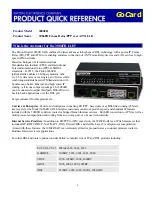
17
<Sysname> system-view
[Sysname] user-interface vty 0 15
[Sysname-ui-vty0-15] authentication-mode none
[Sysname-ui-vty0-15] user privilege level 1
# Authenticate users logged in to the switch through Telnet, verify their password, and specify their user
privilege level as 2.
<Sysname> system-view
[Sysname] user-interface vty 0 15
[Sysname-ui-vty1] authentication-mode password
[Sysname-ui-vty0-15] set authentication password cipher 12345678
[Sysname-ui-vty0-15] user privilege level 2
By default, Telnet users can use level 0 commands after passing authentication. After the configuration
above is completed, when users log in to the switch through Telnet, they must enter the password
12345678
, and then they can use level 0, 1, and 2 commands.
NOTE:
•
For more information about user interfaces, see the chapter “Login methods.” For more information
about the
user-interface
,
authentication-mode
, and
user privilege level
commands, see
Fundamentals
Command Reference.
•
For more information about AAA authentication, see
Security Configuration Guide. For more
information about the
local-user
and
authorization-attribute
commands, see
Security Command
Reference.
•
For more information about SSH, see
Security Configuration Guide.
Switching user privilege level
Introduction
Users can switch to a different user privilege level temporarily without logging out and terminating the
current connection. After the privilege level switching, users can continue to configure the switch without
logging back in, but the commands that they can execute have changed. For example, if the current user
privilege level is 3, the user can configure system parameters. After switching to user privilege level 0, the
user can only execute simple commands, like
ping
and
tracert
, and only a few
display
commands. The
switching operation is effective for the current login. After the user logs back in, the user privilege restores
to the original level.
•
To avoid problems, H3C recommends that administrators log in to the switch by using a lower
privilege level and view switch operating parameters. To maintain the switch, administrators can
temporarily switch to a higher level.
•
If the administrators need to leave or need to ask someone else to temporarily manage the switch,
they can switch to a lower privilege level to restrict the operation by others.
Setting the authentication mode for user privilege level switching
•
A user can switch to a privilege level equal to or lower than the current one unconditionally and is
not required to enter a password (if any).
•
For security, a user is required to enter the password (if any) to switch to a higher privilege level. The
authentication falls into one of the following four categories:
















































